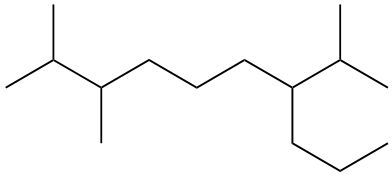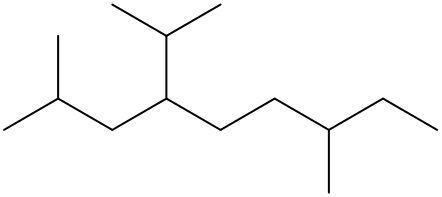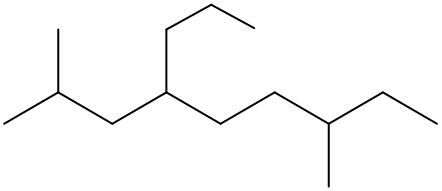So when it comes to naming Organic Compounds, the name consists of a parent chain, the name of substituents and their locations, and a substituent. Now, a substituent, we're going to say, is an alkyl group that branches off the parent chain. For this portion of naming, we're going to say the name format is the location of our substituent, and then ending with the parent name. Alright. So as we do more and more of these, the name format's going to become second nature to everyone. So, just pay attention, and take care because there are steps involved, a process. Remembering the process is the easiest way to name any organic compound you come face to face with.
- 1. Matter and Measurements4h 29m
- What is Chemistry?5m
- The Scientific Method9m
- Classification of Matter16m
- States of Matter8m
- Physical & Chemical Changes19m
- Chemical Properties8m
- Physical Properties5m
- Intensive vs. Extensive Properties13m
- Temperature (Simplified)9m
- Scientific Notation13m
- SI Units (Simplified)5m
- Metric Prefixes24m
- Significant Figures (Simplified)11m
- Significant Figures: Precision in Measurements7m
- Significant Figures: In Calculations19m
- Conversion Factors (Simplified)15m
- Dimensional Analysis22m
- Density12m
- Specific Gravity9m
- Density of Geometric Objects19m
- Density of Non-Geometric Objects9m
- 2. Atoms and the Periodic Table5h 23m
- The Atom (Simplified)9m
- Subatomic Particles (Simplified)12m
- Isotopes17m
- Ions (Simplified)22m
- Atomic Mass (Simplified)17m
- Atomic Mass (Conceptual)12m
- Periodic Table: Element Symbols6m
- Periodic Table: Classifications11m
- Periodic Table: Group Names8m
- Periodic Table: Representative Elements & Transition Metals7m
- Periodic Table: Elemental Forms (Simplified)6m
- Periodic Table: Phases (Simplified)8m
- Law of Definite Proportions9m
- Atomic Theory9m
- Rutherford Gold Foil Experiment9m
- Wavelength and Frequency (Simplified)5m
- Electromagnetic Spectrum (Simplified)11m
- Bohr Model (Simplified)9m
- Emission Spectrum (Simplified)3m
- Electronic Structure4m
- Electronic Structure: Shells5m
- Electronic Structure: Subshells4m
- Electronic Structure: Orbitals11m
- Electronic Structure: Electron Spin3m
- Electronic Structure: Number of Electrons4m
- The Electron Configuration (Simplified)22m
- Electron Arrangements5m
- The Electron Configuration: Condensed4m
- The Electron Configuration: Exceptions (Simplified)12m
- Ions and the Octet Rule9m
- Ions and the Octet Rule (Simplified)8m
- Valence Electrons of Elements (Simplified)5m
- Lewis Dot Symbols (Simplified)7m
- Periodic Trend: Metallic Character4m
- Periodic Trend: Atomic Radius (Simplified)7m
- 3. Ionic Compounds2h 18m
- Periodic Table: Main Group Element Charges12m
- Periodic Table: Transition Metal Charges6m
- Periodic Trend: Ionic Radius (Simplified)5m
- Periodic Trend: Ranking Ionic Radii8m
- Periodic Trend: Ionization Energy (Simplified)9m
- Periodic Trend: Electron Affinity (Simplified)8m
- Ionic Bonding6m
- Naming Monoatomic Cations6m
- Naming Monoatomic Anions5m
- Polyatomic Ions25m
- Naming Ionic Compounds11m
- Writing Formula Units of Ionic Compounds7m
- Naming Ionic Hydrates6m
- Naming Acids18m
- 4. Molecular Compounds2h 18m
- Covalent Bonds6m
- Naming Binary Molecular Compounds6m
- Molecular Models4m
- Bonding Preferences6m
- Lewis Dot Structures: Neutral Compounds (Simplified)8m
- Multiple Bonds4m
- Multiple Bonds (Simplified)6m
- Lewis Dot Structures: Multiple Bonds10m
- Lewis Dot Structures: Ions (Simplified)8m
- Lewis Dot Structures: Exceptions (Simplified)12m
- Resonance Structures (Simplified)5m
- Valence Shell Electron Pair Repulsion Theory (Simplified)4m
- Electron Geometry (Simplified)8m
- Molecular Geometry (Simplified)11m
- Bond Angles (Simplified)11m
- Dipole Moment (Simplified)15m
- Molecular Polarity (Simplified)7m
- 5. Classification & Balancing of Chemical Reactions3h 17m
- Chemical Reaction: Chemical Change5m
- Law of Conservation of Mass5m
- Balancing Chemical Equations (Simplified)13m
- Solubility Rules16m
- Molecular Equations18m
- Types of Chemical Reactions12m
- Complete Ionic Equations18m
- Calculate Oxidation Numbers15m
- Redox Reactions17m
- Spontaneous Redox Reactions8m
- Balancing Redox Reactions: Acidic Solutions17m
- Balancing Redox Reactions: Basic Solutions17m
- Balancing Redox Reactions (Simplified)13m
- Galvanic Cell (Simplified)16m
- 6. Chemical Reactions & Quantities2h 35m
- 7. Energy, Rate and Equilibrium3h 46m
- Nature of Energy6m
- First Law of Thermodynamics7m
- Endothermic & Exothermic Reactions7m
- Bond Energy14m
- Thermochemical Equations12m
- Heat Capacity19m
- Thermal Equilibrium (Simplified)8m
- Hess's Law23m
- Rate of Reaction11m
- Energy Diagrams12m
- Chemical Equilibrium7m
- The Equilibrium Constant14m
- Le Chatelier's Principle23m
- Solubility Product Constant (Ksp)17m
- Spontaneous Reaction10m
- Entropy (Simplified)9m
- Gibbs Free Energy (Simplified)18m
- 8. Gases, Liquids and Solids3h 25m
- Pressure Units6m
- Kinetic Molecular Theory14m
- The Ideal Gas Law18m
- The Ideal Gas Law Derivations13m
- The Ideal Gas Law Applications6m
- Chemistry Gas Laws16m
- Chemistry Gas Laws: Combined Gas Law12m
- Standard Temperature and Pressure14m
- Dalton's Law: Partial Pressure (Simplified)13m
- Gas Stoichiometry18m
- Intermolecular Forces (Simplified)19m
- Intermolecular Forces and Physical Properties11m
- Atomic, Ionic and Molecular Solids10m
- Heating and Cooling Curves30m
- 9. Solutions4h 10m
- Solutions6m
- Solubility and Intermolecular Forces18m
- Solutions: Mass Percent6m
- Percent Concentrations10m
- Molarity18m
- Osmolarity15m
- Parts per Million (ppm)13m
- Solubility: Temperature Effect8m
- Intro to Henry's Law4m
- Henry's Law Calculations12m
- Dilutions12m
- Solution Stoichiometry14m
- Electrolytes (Simplified)13m
- Equivalents11m
- Molality15m
- The Colligative Properties15m
- Boiling Point Elevation16m
- Freezing Point Depression9m
- Osmosis16m
- Osmotic Pressure9m
- 10. Acids and Bases3h 29m
- Acid-Base Introduction11m
- Arrhenius Acid and Base6m
- Bronsted Lowry Acid and Base18m
- Acid and Base Strength17m
- Ka and Kb12m
- The pH Scale19m
- Auto-Ionization9m
- pH of Strong Acids and Bases9m
- Acid-Base Equivalents14m
- Acid-Base Reactions7m
- Gas Evolution Equations (Simplified)6m
- Ionic Salts (Simplified)23m
- Buffers25m
- Henderson-Hasselbalch Equation16m
- Strong Acid Strong Base Titrations (Simplified)10m
- 11. Nuclear Chemistry56m
- BONUS: Lab Techniques and Procedures1h 38m
- BONUS: Mathematical Operations and Functions47m
- 12. Introduction to Organic Chemistry1h 34m
- 13. Alkenes, Alkynes, and Aromatic Compounds2h 12m
- 14. Compounds with Oxygen or Sulfur1h 6m
- 15. Aldehydes and Ketones1h 1m
- 16. Carboxylic Acids and Their Derivatives1h 11m
- 17. Amines38m
- 18. Amino Acids and Proteins1h 51m
- 19. Enzymes1h 37m
- 20. Carbohydrates1h 46m
- Intro to Carbohydrates4m
- Classification of Carbohydrates4m
- Fischer Projections4m
- Enantiomers vs Diastereomers8m
- D vs L Enantiomers8m
- Cyclic Hemiacetals8m
- Intro to Haworth Projections4m
- Cyclic Structures of Monosaccharides11m
- Mutarotation4m
- Reduction of Monosaccharides10m
- Oxidation of Monosaccharides7m
- Glycosidic Linkage14m
- Disaccharides7m
- Polysaccharides7m
- 21. The Generation of Biochemical Energy2h 8m
- 22. Carbohydrate Metabolism2h 22m
- 23. Lipids2h 26m
- Intro to Lipids6m
- Fatty Acids25m
- Physical Properties of Fatty Acids6m
- Waxes4m
- Triacylglycerols12m
- Triacylglycerol Reactions: Hydrogenation8m
- Triacylglycerol Reactions: Hydrolysis13m
- Triacylglycerol Reactions: Oxidation7m
- Glycerophospholipids15m
- Sphingomyelins13m
- Steroids15m
- Cell Membranes7m
- Membrane Transport10m
- 24. Lipid Metabolism1h 45m
- 25. Protein and Amino Acid Metabolism1h 37m
- 26. Nucleic Acids and Protein Synthesis2h 54m
- Intro to Nucleic Acids4m
- Nitrogenous Bases16m
- Nucleoside and Nucleotide Formation9m
- Naming Nucleosides and Nucleotides13m
- Phosphodiester Bond Formation7m
- Primary Structure of Nucleic Acids11m
- Base Pairing10m
- DNA Double Helix6m
- Intro to DNA Replication20m
- Steps of DNA Replication11m
- Types of RNA10m
- Overview of Protein Synthesis4m
- Transcription: mRNA Synthesis9m
- Processing of pre-mRNA5m
- The Genetic Code6m
- Introduction to Translation7m
- Translation: Protein Synthesis18m
Naming Alkanes with Substituents - Online Tutor, Practice Problems & Exam Prep
 Created using AI
Created using AINative organic compounds are named using a systematic approach that includes identifying the parent chain, substituents, and their locations. A substituent, typically an alkyl group, branches off the parent chain. The naming format follows the structure: location of the substituent followed by the parent name. Mastering this process simplifies the naming of organic compounds, which is essential for understanding concepts like functional groups, isomers, and reaction mechanisms in organic chemistry.
Rules for Naming Alkanes with Substituents Concept 1
Video transcript
Naming Alkanes with Substituents Example 1
Video transcript
Here it says, give the systematic name of the following alkane. Right. So to name this, we're going to have to follow the given steps. So, step 1, we find the longest carbon chain, which is the parent chain, and assign names according to the prefixes. Now, if there's a tie between the longest chain, choose the chain with more substituents. Now, when it comes to finding the longest carbon chain, you have to let go of the fact that we're reading from left to right. When it comes to looking at an organic molecule, you may look left to right, right to left, top to bottom, or bottom to top. You have to be able to look in all directions. So if we take a look here, what's the longest possible chain? Let's see. 1, 2, 3, 4. Okay. 1, 2, 3, 4, 5, 6, 7. 1, 2, 3, 4, 5, 6, 7. So it looks like there are 2 ways that give me 7. And regardless of which way you go, if we went this way, we'd have 2 substituents. This one branching off and this one branching off. If we went the other way, it'd be the same thing, where going this way, we'd have these 2 substituents. Alright. So our longest carbon chain is 7 carbons long.
Now, step 2, assign names to all substituents, and this is important. Step 3. Start numbering the chain from the closest substituent. If there's a tie between substituents, compare the next closest substituent. If still a tie, number in alphabetical order. Alright. So if we go down here, I've highlighted what we were just talking about. The longest carbon chain I decided to highlight it this way. This gives me a 7 carbon chain as the parent chain. And what's highlighted in orange are our substituents. So here we go 1-2-3, we get to this substituent, we go 1-2-3, we get to this substituent. It's tied. Counting the carbon 3 from either side gets us to a substituent. But if we identify these, this is 1 carbon, so this would be a methyl group. This is 2 carbons, so this is an ethyl group. We said, if still a tie, distance from the ends to the first substituent, number in alphabetical order. E comes before M, which means we're going to number it this way, 1-2-3, and then 4, 5, 6, 7.
Now, step 4, you're going to assign numbers, which gives us the location for each substituent. When more than 1 identical substituent, use the numerical prefixes of di for 2, tri for 3, and tetra for 4. Alright. So we have on carbon number 3, an ethyl. So this we're going to say, we're going to use 3-ethyl. Okay. Name substituents in alphabetical order. Prefixes do not count, use commas to separate numbers from numbers, and we're going to use dashes to separate letters from numbers. Letters are not separated from letters. So a lot is being said here, so let's work this out. We're going to name the substituents alphabetically, and we're going to give their number locations. So ethyl is on carbon number 3, so that's 3-ethyl. Methyl's on carbon number 5, so 5-methyl, and then we have a 7 carbon chain. 7 carbons is hept, and it's an alkane, so it's heptane. So this would be the name of this alkyl group, or this alkane molecule. 3-Ethyl-5-Methyl-heptane. This would be our final answer. Again, it gets a little bit jarring in terms of naming these types of molecules, but with enough practice it becomes second nature. So keep at it, and you'll get to master naming all these different types of organic compounds.
Provide a systematic name for the molecule.
7-isopropyl-2,3-dimethyldecane
2,7,8-trimethyl-3-propylnonane
4-isopropyl-8,9-dimethyldecane
2,3,8-trimethyl-7-propylnonane
Draw a structure for 2,6-dimethyl-4-propylnonane.
Draw a structure for 4-tert-butyl-3-isopropyl-2-methyloctane.
Do you want more practice?
Here’s what students ask on this topic:
What is the process for naming alkanes with substituents?
Naming alkanes with substituents involves several steps. First, identify the longest continuous carbon chain, which will serve as the parent chain. Next, identify and name the substituents, which are alkyl groups branching off the parent chain. Number the carbon atoms in the parent chain starting from the end nearest a substituent to give the substituents the lowest possible numbers. Finally, write the name by listing the substituents in alphabetical order, each preceded by its location number, followed by the parent chain name. For example, 2-methylpentane indicates a methyl group on the second carbon of a five-carbon chain.
 Created using AI
Created using AIHow do you determine the parent chain in an alkane?
The parent chain in an alkane is the longest continuous chain of carbon atoms. If there are multiple chains of the same length, choose the one with the most substituents. This ensures that the naming process reflects the most complex structure. For example, in a molecule with chains of six and seven carbons, the seven-carbon chain is the parent chain. If two chains of equal length exist, select the one with the greatest number of substituents.
 Created using AI
Created using AIWhat are common mistakes to avoid when naming alkanes with substituents?
Common mistakes include not identifying the longest parent chain, incorrectly numbering the carbon atoms, and not listing substituents in alphabetical order. Always ensure the parent chain is the longest possible, number the chain to give substituents the lowest possible numbers, and list substituents alphabetically regardless of their position. For example, in 3-ethyl-2-methylhexane, 'ethyl' comes before 'methyl' alphabetically, even though 'methyl' is on the second carbon.
 Created using AI
Created using AIHow do you name a compound with multiple substituents?
When naming a compound with multiple substituents, first identify the parent chain and number it to give the substituents the lowest possible numbers. List each substituent with its corresponding number, and if there are multiple identical substituents, use prefixes like di-, tri-, and tetra-. For example, 2,3-dimethylbutane indicates two methyl groups on the second and third carbons of a four-carbon chain. Always list substituents in alphabetical order, ignoring prefixes when alphabetizing.
 Created using AI
Created using AIWhat is the significance of the IUPAC naming system in organic chemistry?
The IUPAC naming system provides a standardized method for naming organic compounds, ensuring clear and consistent communication among chemists worldwide. It helps avoid confusion by providing a unique name for each compound based on its structure. This system is essential for understanding and discussing chemical reactions, mechanisms, and properties. For example, the name 2-methylpropane immediately conveys the structure of the compound, allowing chemists to understand its reactivity and behavior in different contexts.
 Created using AI
Created using AIYour GOB Chemistry tutor
- The following names are incorrect. Tell what is wrong with each, and provide the correct names. <IMAGE>
- The following names are incorrect. Tell what is wrong with each, and provide the correct names. <IMAGE>
- Write condensed structures for the following compounds:4-tert-Butyl-2-methylheptane
- Write condensed structures for the following compounds:4,4-Diethyl-3-methyloctane
- What are the IUPAC names of the following alkanes? <IMAGE>
- What are the IUPAC names of the following alkanes? <IMAGE>
- The following names are incorrect. Write the structural formula that agrees with the apparent name, and then w...
- Give the IUPAC name for each of the following:c. <IMAGE>
- Give the IUPAC name for each of the following:c. <IMAGE>
- Draw the line-angle formula for each of the following:a. 3-methylheptane
- Convert each of the following line-angle formulas to a condensed structural formula and give its IUPAC name: (...
- Give the IUPAC name for each of the following: (11.3)c. <IMAGE>
- Draw the skeletal structure for each of the following compounds:(a) 2,3-dimethylpentane
- Draw the skeletal structure for each of the following compounds:(a) 3-ethylhexane
- Give the correct IUPAC name for each of the following compounds:(a) <IMAGE>
- Give the correct IUPAC name for each of the following compounds:(c) <IMAGE>
- Give the correct IUPAC name for each of the following compounds:(b) <IMAGE>









